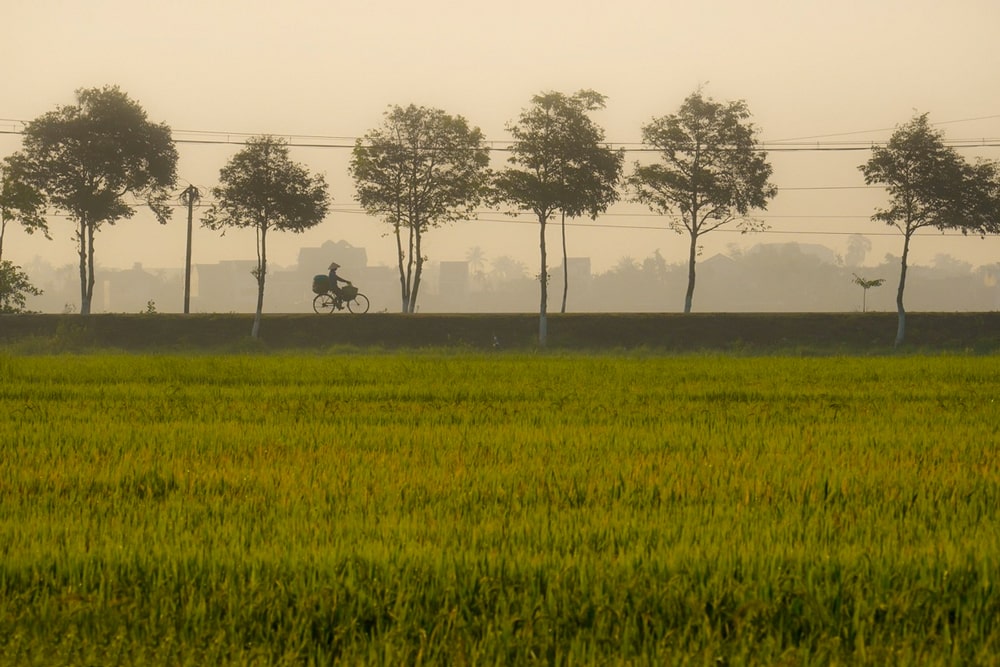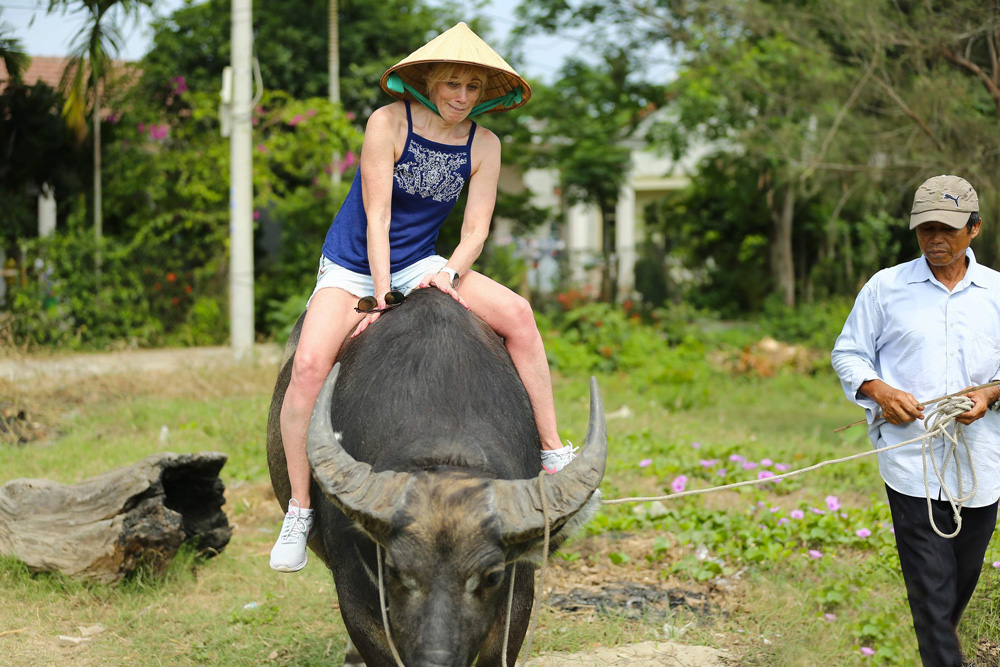Explore the Tra Que Village in Hoi An from A to Z
Located between Hoi An’s picturesque old town and the peaceful An Bang beach, Tra Que village offers a unique excursion in Hoi An. Renowned for its high-quality vegetables and herbs, essential to local cuisine, the village was founded centuries ago.
The farmers of Tra Que use unique, completely chemical-free cultivation methods to produce their prized herbs. This is why the village’s agricultural products feature in Hoi An’s best dishes, such as Cao Lau.
This article provides all the information you need to make the most of your visit to Tra Que. Follow the guide.
Brief Overview of Tra Que Village

Located 3km from Hoi An, Tra Que (pronounced Tcha wé) is a charming little village situated in Cam Ha near Hoi An, on Hai Ba Trung road heading towards An Bang beach after the first bridge. The village is divided into two parts and consists of small eco-gardens.
What makes Tra Que vegetable village so special? The farmers at Tra Que abstain from using harsh chemicals, toxins, or even manure as fertilizer. Instead, a completely natural seaweed found exclusively in the lagoon of Tra Que vegetable village is used to create the freshest and cleanest produce.

Tra Que gets its name from the tastes and aromas of the vegetable village, literally translating to “cinnamon tea.”
The vegetable garden of Tra Que is surrounded by the De Vong River and the Tra Que lagoon. It was established over 300 years ago when the inhabitants were primarily fishers.
However, after discovering the benefits of the lagoon’s seaweed manure and the rich fertile soil of the village, the locals began to grow vegetables and herbs and have continued to do so since.

The increasingly vast 40 hectares of Tra Que vegetable garden are home to approximately 200 families. All work to sell their fresh produce to restaurants and households in Hoi An.
Farmers here typically hope to earn about 150,000 VND per day. Many tourists who visit here improve their way of life.

A total of 41 herbs and vegetables are currently grown by the farmers of the village, ranging from winter melon and water spinach to amaranth and turmeric. It only takes 20 days from the day the seeds are planted until they are harvested.
After agriculture, tourism is the second source of income for the locals. All bike tours without exception make a stop at the village, giving you a chance to try out the techniques yourself and realize the difficulty of traditional farming, especially using double watering cans.
GOOD TO KNOW
When to Visit Tra Que Village in Hoi An?
The village wakes up early, at 5 AM, and there will be no one around at noon and in the early afternoon due to siesta time.
If the temperature is too high, you will hardly see anyone. Choose your visiting times wisely if you wish to see the inhabitants of Tra Que.
It is advised to visit around 5:30 AM or 6 AM in the morning or 4:30 PM to 5 PM in the evening.
Ticket Price for Tra Que Village
Each visitor will pay 30,000 VND to enter and visit Tra Que vegetable village. Ticket booths are located on the main roads leading to the gardens and tourist sites. However, I’ve encountered several tourists who have bypassed this and did not have to purchase this entry fee.
How to Get There

The Tra Que vegetable village is ideally situated close to all key locations around Hoi An. Tourists staying near the old town or An Bang beach often choose to walk there, with distances being about 3 km and 1.5 km respectively. Between the city and the village, green, wind-swept rice paddies line each side of the main road, Hai Ba Trung. At sunset, the landscape becomes breathtaking, drawing many pedestrians and onlookers.
Located in the countryside, Tra Que village is a frequent stop on many cycling routes, whether self-guided or organized. Taking a short taxi ride is also a convenient and cost-effective way to reach Tra Que village. The cost for a four-seater car ranges from 30,000 to 150,000 VND, depending on where you start the journey. If you need a taxi to continue to your next destination, simply head to the main road, Hai Ba Trung, and hail a taxi.
What to Do in Tra Que?
Here is a brief, non-exhaustive list of activities available on-site. If you are short on time and want to explore the village on your own, it’s also a great option.
Rent a bike, tour the vegetable gardens, visit the gardens, and see how the farmers work. The residents are very welcoming and always accommodate tourists, although their English may not be very good.
1. Self-Guided Tour of the Village
Before focusing on any specific point of interest, visiting the Tra Que vegetable village is a must-do experience. Whether you choose to walk or bike, you will have the opportunity to see slices of local life, smiling faces, and peaceful rural landscapes, allowing you to escape from the hustle and bustle of Hoi An’s old town.
Navigating the village is not very difficult as it is quite small and has easily memorable landmarks. From the main Hai Ba Trung road, whether you turn left or right, you will be able to see vegetable gardens with farmers at work.
Looking to take beautiful photos? Early in the morning (around 5:30 AM) is the best time to capture them, when the locals are in their gardens tending to the plants.
2. Discover the Flavors of Herbs and Vegetables

Learning vegetable cultivation techniques with the locals is a hallmark experience in Tra Que Village. You will learn how to hoe the soil, plow, grind, fertilize with seaweed, transplant young vegetables, water with well water using a shoulder pole, and cover crops to protect them.
These instructions are provided by a farmer who shares his daily methods. Although simple, these activities offer entertaining moments for the whole family and are especially enjoyed by children. The host also serves as a tour guide, presenting the different types of herbs in his garden and sharing their names, appearances, flavors, and uses.
3. Try the Double Watering Cans

One of the attractions of the village is using the double watering cans as shown in the photo above. It’s one of the unique features of the farmers in Tra Que. It’s a great moment of laughter to try it out. Unfortunately, this technique is increasingly being lost with the widespread use of automatic watering in the Tra Que village.
You can ask a farmer directly to try it, and generally, they will not refuse. If you are on a guided tour, your guide will have you try it out.
4. Ride a Water Buffalo and Explore the Surroundings

Even though it’s not a characteristic activity of the village, you can ride a water buffalo. It’s a popular activity among tourists. Having tried it myself, I can say it was quite an experience.
Additionally, you can explore the surroundings of the gardens, including the rice paddies, where you can observe local life.
5. Cooking Class at Tra Que

Cooking classes are one of the popular activities in Tra Que. Unlike cooking classes in Hoi An, here you can harvest directly from the garden and cook with the vegetables you pick.
My recommendation
One of the best cooking classes in Tra Que is offered by Baby Mustard restaurant. You will have a perfect view of the gardens. Opened in 2012, this restaurant has been managed by women for three generations.
Opening hours: 11 AM to 9 PM daily
Phone number: +84935725749
Email: babymustard.restaurant@gmail.com
6. Van Duc Pagoda

Van Duc Pagoda is the largest pagoda in Hoi An. Just the gate of the pagoda itself is worth a look.
After crossing the first bridge on Hai Ba Trung street, turn left and continue for 2km, and you will find Van Duc Pagoda where you can meet Buddhists living inside.
The doors of the pagoda are magnificent, and inside, several white marble Buddhas are truly beautiful.
This is a bonus stop and allows you to visit the surroundings of Tra Que.






